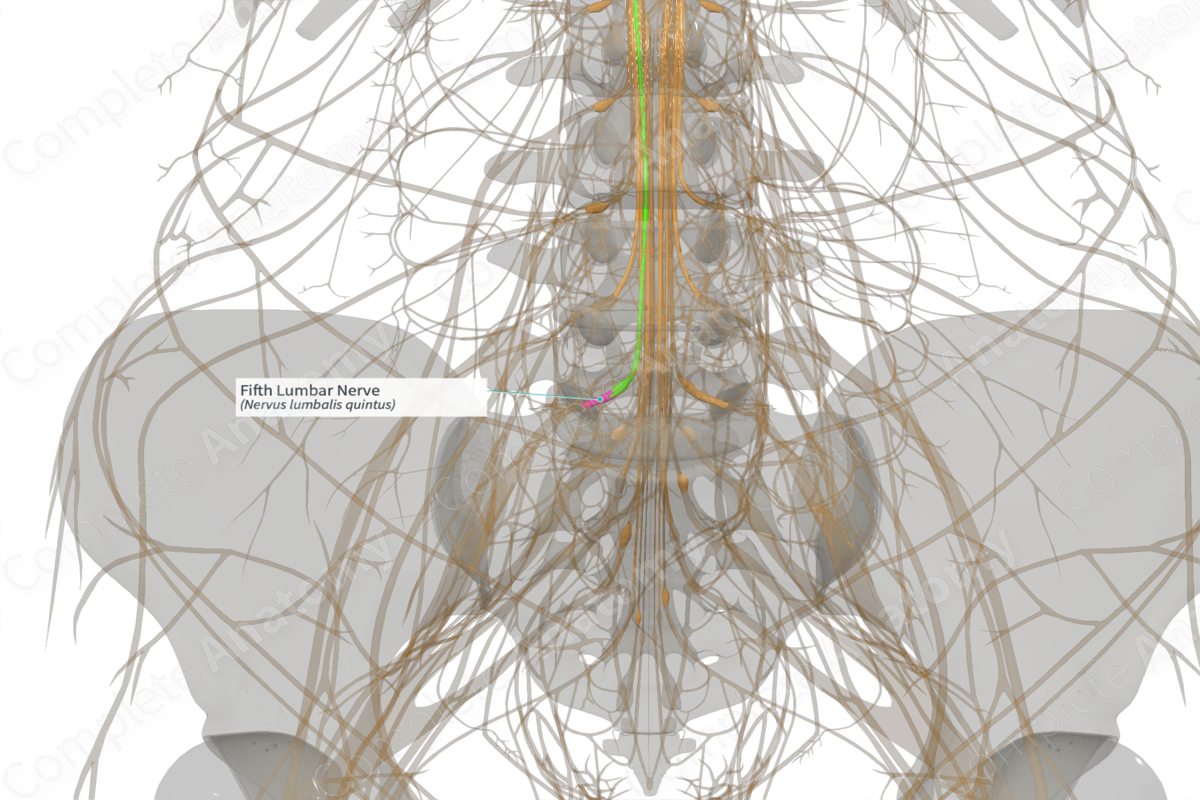
Quick Facts
Origin: The intervertebral foramen inferior to the fifth lumbar vertebra.
Course: Inferiorly to the sacral plexus.
Branches: superior gluteal, inferior gluteal, and sciatic nerves.
Supply:
Motor innervation to epaxial back muscles, tensor fascia latae, gluteal muscles, gastrocnemius, tibialis anterior, extensor hallucis longus, and extensor digitorum brevis.
Sensory innervation for the skin of back (lumbar levels), lateral leg, dorsal and plantar surfaces of the foot.
Origin
The fifth lumbar nerve originates in, or just lateral, to the intervertebral foramen, inferior to the fifth lumbar vertebra. Here, the anterior and posterior roots combine to form the fifth lumbar nerve proper.
Course
The fifth lumbar nerve gives off a posterior ramus running to the epaxial musculature and skin of the lower back, and an anterior ramus that runs inferior and lateral to the sacral plexus.
Branches
The fifth lumbar nerve gives off a posterior ramus and contributes to the lumbosacral trunk through its anterior ramus. The fifth lumbar fibers of the lumbosacral trunk contribute to the superior gluteal, inferior gluteal, and sciatic nerves of the sacral plexus.
Supplied Structures
The posterior ramus of the fifth lumbar nerve supplies the epaxial muscles of the lumbar region, including erector spinae and transversospinal muscles. In addition to cutaneous innervation to the skin over the lower back.
The anterior ramus of the fifth lumbar nerve contributes to the lumbosacral trunk, sacral plexus, and the following nerves and targets:
—The superior gluteal nerve arises from the fourth and fifth lumbar nerves, as well as the first sacral nerve. It innervates gluteus medius, gluteus minimus, and tensor fasciae latae muscles. This nerve has no sensory component.
—The inferior gluteal nerve arises from the fifth lumbar nerve and the first and second sacral nerves. It innervates the gluteus maximus muscle. There is no sensory component to this nerve.
—The sciatic nerve is the largest nerve in the body. It gives rise to the common fibular, tibial, and sural nerves. It arises from the fourth and fifth lumbar nerves, as well as the first, second, and third sacral nerves. The sciatic nerve innervates all the muscles of the posterior thigh, anterior and posterior leg, and foot. However, the fifth lumbar nerve contributes primarily to the innervation of gastrocnemius, tibialis anterior, extensor hallucis longus, and extensor digitorum brevis muscles. Sensory innervation of the sciatic nerve is to the leg and foot. The fifth lumbar nerve carries sensory information primarily from the lateral leg, dorsum of the foot, and plantar surface of the foot.
List of Clinical Correlates
—Trendelenburg sign
—Sciatica
—Disc herniation
—Lumbar stenosis
Learn more about this topic from other Elsevier products

